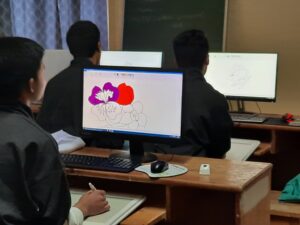


Tshemdrup, the art of embroidery, is an essential part of Bhutan’s cultural heritage and is one of the Zorig Chusum (13 traditional arts and crafts). Tshemdrup is a traditional craft with religious significance and is incorporated in numerous religious textiles and tapestries of rich cultural and religious icons. These days, it is also featured in numerous textile and accessories like traditional scarves, boots, blankets, and ritual altar pieces.
Tshemdrup students learn the intricate art of Embroidery but in CTAS, they also have to undergo the basics of drawing and painting rimo so that they can work independently and not have to rely on other people to do the initial drawings.

Tshemdrup Level One students are taught the fundamental rimo of luroe (sheep’s horn), patra sumpa, patra ngapa, patra duenpa, patra chusum pa, and the Eight Lucky Signs.
Tshemdrup Level One students are taught to sew kupe khathang (twisting thread), chachapthang, zhungdrel thang and the Eight Lucky Signs.
Tshemdrup students learn the intricate art of Embroidery but in CTAS, they also have to undergo the basics of drawing rimo so that they can work independently and not have to rely on other people to do the initial drawings.
Tshemdrup Level Two learn to draw the lokhor chuni (the twelve year animals), the four auspicious animals; tag (tiger), sing (lion), chung (garuda) and druk (dragon) and the tshepatra (mythical cat).
Tshemdrup Level Three students are taught to draw thuenpapunzhi cherbu (the four harmonious friends), toenpa zha, cha and zhab (Buddha mouth, eye and leg) and toenpa cherbu and namzha chachang.
In the embroidery part, Tshemzo Level Three students are taught chen nam sum (eye, ear and mouth), toenpa kuchang (single Buddha), and the sangay menlha (medicine Buddha). The students also learn the art of traditional boot making (Tsholham). They learn ways to cut materials, take measurements, use simple sewing machine to sew plain traditional boots and use the Bernnia 560 machine and software to design different patterns.
Tshemdrup Level Four students are taught to draw tara thiksey, tara cherub, namzha chachang, guru cherbu and namzha chatshang (second Buddha).
In the embroidery part, Tshemdrup Level Four the student are taught green tara, guru tshokhor sum (second Buddha with his two disciples), thuenpapunzhi patchwork (the four friends) and drab marchen/chana dorji (vajarapani). With the incorporation of NC 3 level, it is mandatory for the students to know how to use the embroidery machine so that students can produce high quality works by using machine design and hand embroidered work.
Tshemdrup Level Five students are considered to be in the professional program because it is a transitional period from school to the real world. Students are introduced to the job market by school alumni and get advice from alumnus who have already gained significant knowledge about doing tshemdrup in the real world.


In 2020, the school is fortunate enough to receive support from Ustinov Foundation to introduce a boot-making class to the Tailoring course.
Furthermore, the school even received professional help on this matter from a local expert, who had been an instructor in a national institute prior to his requirement. He, not only trained the current embroidery teacher the art of traditional boot-making for two weeks but also came to the school on several occasions to validate the teaching-learning process on traditional boot-making. Adding this skill set to the current CTAS curriculum has enhanced the overall attractiveness of the course, can potentially increase student employability rate in the market and help preserve the art of traditional boot-making.
Tshemdrup students are required to complete six-ten weeks of On the Job Training (OJT), a period of internship that offers students practical experience.
In order to get promoted to next level, students are assessed on a monthly basis and have to clear the exam. Students are expected to take exams twice a year, in July and in December. By the end of the year, the students are expected to draw rimo accurately from memory, make their own blue print designs, understand the sequence of painting and paint as per the requirements.
By the end of the year, the students are expected to draw and embroider on brocade and carry out patch work independently to make small and large thangkas. In order to get the degree certificate the student are assessed on the hardship basis of their work and have to clear the exam successfully.

Students learn basic computer skills such as typing, creating slides, using the internet as a resource and basic graphic design. The program was introduced in 2012 with the objective to provide basic IT knowledge.

Students learn simple Dzongkha with the basic skills of reading and writing in Dzongkha. Since Dzongkha is a key aspect of our culture, students are taught Dzongkha to enrich their craft and learning experience.

Students learn simple English with the basic skills of reading, writing, listening and speaking in English. They learn to comprehend simple texts and hold conversations in english.

Students learn simple math skills like adding, subtracting, multiplying and dividing numbers to solve problems. They also learn basic formulas and equations.

© Choki Traditional Art School. All rights reserved 2021